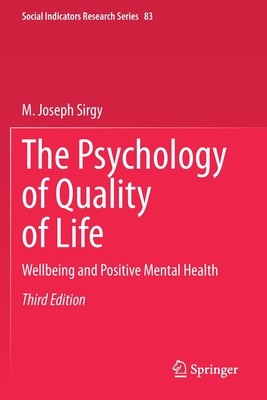
- We will send in 10–14 business days.
- Author: M Joseph Sirgy
- Publisher: Springer
- ISBN-10: 3030718905
- ISBN-13: 9783030718909
- Format: 15.6 x 23.4 x 4.2 cm, softcover
- Language: English
- SAVE -10% with code: EXTRA
Reviews
Description
Preface
Part I: Introduction
Chapter 1: Philosophical Foundations, Definitions, and Measures of Wellbeing
Chapter 2: Further Distinctions among Major Concepts of Wellbeing
Chapter 3: Positive Outcomes of Wellbeing
Part II: Objective Reality and Effects on Wellbeing
Chapter 4: Effects of Technological, Economic, Political, and Socio-Cultural Factors on Wellbeing
Chapter 5: Effects of Resources (Time, Money, Income, and Wealth) on Wellbeing
Chapter 6: Effects of Demographic Factors on Wellbeing
Chapter 7: Effects of Personal and Consumption Activities on Wellbeing
Chapter 8: Effects of Biology, Drugs, Life Events, and the Environment on Wellbeing
Part III: Subjective Reality and Effects on Wellbeing
Chapter 9: Effects of Personality on Wellbeing
Chapter 10: Effects of Affect and Cognition on Wellbeing
Chapter 11: Effects of Beliefs and Values on Wellbeing
Chapter 13: Effects of Goals on Wellbeing
Chapter 14: Effects of Self-Concept on WellbeingChapter 15: Effects of Social Comparisons on Wellbeing
Part IV: Life Domains and Effects on Wellbeing
Chapter 16: Effects of Domain Dynamics on Wellbeing
Chapter 17: Work Wellbeing
Chapter 18: Residential Wellbeing
Chapter 19: Material Wellbeing
Chapter 20: Social, Family, and Marital Wellbeing
Chapter 21: Health Wellbeing
Chapter 22: Leisure Wellbeing
Chapter 23: Wellbeing in Other Life Domains
Part V: Population Segments and Wellbeing
Chapter 24: The Wellbeing of Children and Youth
Chapter 25: The Wellbeing of Older Adults
Chapter 26: The Wellbeing of Women
Chapter 27: The Wellbeing of Geographic Population Segments
Chapter 28: The Wellbeing of Specialty Population Segments
Part VI: Epilogue
Chapter 29: Integrative Models of Wellbeing
Chapter 30: Philosophy and Public Policy Issues Related to Wellbeing
Appendix: Wellbeing Measurement Issues
Index
EXTRA 10 % discount with code: EXTRA
The promotion ends in 20d.01:04:54
The discount code is valid when purchasing from 10 €. Discounts do not stack.
- Author: M Joseph Sirgy
- Publisher: Springer
- ISBN-10: 3030718905
- ISBN-13: 9783030718909
- Format: 15.6 x 23.4 x 4.2 cm, softcover
- Language: English English
Preface
Part I: Introduction
Chapter 1: Philosophical Foundations, Definitions, and Measures of Wellbeing
Chapter 2: Further Distinctions among Major Concepts of Wellbeing
Chapter 3: Positive Outcomes of Wellbeing
Part II: Objective Reality and Effects on Wellbeing
Chapter 4: Effects of Technological, Economic, Political, and Socio-Cultural Factors on Wellbeing
Chapter 5: Effects of Resources (Time, Money, Income, and Wealth) on Wellbeing
Chapter 6: Effects of Demographic Factors on Wellbeing
Chapter 7: Effects of Personal and Consumption Activities on Wellbeing
Chapter 8: Effects of Biology, Drugs, Life Events, and the Environment on Wellbeing
Part III: Subjective Reality and Effects on Wellbeing
Chapter 9: Effects of Personality on Wellbeing
Chapter 10: Effects of Affect and Cognition on Wellbeing
Chapter 11: Effects of Beliefs and Values on Wellbeing
Chapter 13: Effects of Goals on Wellbeing
Chapter 14: Effects of Self-Concept on WellbeingChapter 15: Effects of Social Comparisons on Wellbeing
Part IV: Life Domains and Effects on Wellbeing
Chapter 16: Effects of Domain Dynamics on Wellbeing
Chapter 17: Work Wellbeing
Chapter 18: Residential Wellbeing
Chapter 19: Material Wellbeing
Chapter 20: Social, Family, and Marital Wellbeing
Chapter 21: Health Wellbeing
Chapter 22: Leisure Wellbeing
Chapter 23: Wellbeing in Other Life Domains
Part V: Population Segments and Wellbeing
Chapter 24: The Wellbeing of Children and Youth
Chapter 25: The Wellbeing of Older Adults
Chapter 26: The Wellbeing of Women
Chapter 27: The Wellbeing of Geographic Population Segments
Chapter 28: The Wellbeing of Specialty Population Segments
Part VI: Epilogue
Chapter 29: Integrative Models of Wellbeing
Chapter 30: Philosophy and Public Policy Issues Related to Wellbeing
Appendix: Wellbeing Measurement Issues
Index


Reviews